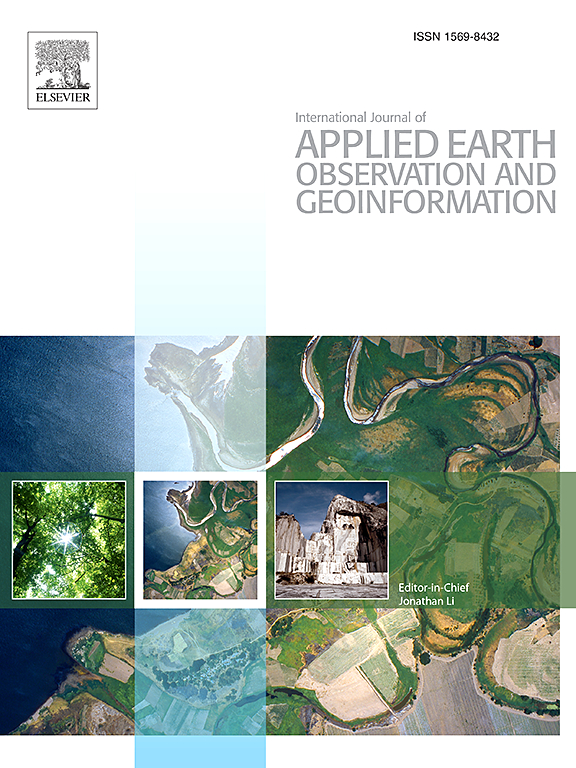Extraction and analysis of aerosol anomalies associated with multiple shallow earthquakes based on MODIS AOD products
IF 7.6
Q1 REMOTE SENSING
International journal of applied earth observation and geoinformation : ITC journal
Pub Date : 2025-06-25
DOI:10.1016/j.jag.2025.104671
引用次数: 0
Abstract
Shallow earthquakes are among the most devastating natural hazards, and aerosol anomalies offer insights into crust–atmosphere interactions critical for earthquake forecasting and environmental assessment. However, standardized anomaly extraction protocols—especially whether to center analyses on epicenters or fault zones—remain undefined, and the driving mechanisms of these anomalies are insufficiently studied. This work utilizes MODIS AOD retrievals and a background field–based Robust Satellite Technique (RST) algorithm to detect AOD anomalies linked to 14 global shallow-focus earthquakes using a 2σ threshold, followed by statistical significance testing (p < 0.05). Spatiotemporal analysis of five representative events reveals that higher-magnitude earthquakes generate stronger (up to 6.28σ) and longer-lasting (≥4 days) AOD perturbations. AOD peaks follow a consistent spatial hierarchy: marine > coastal > inland. Marine anomalies cluster around fault zones; coastal anomalies appear as discrete points near faults; inland anomalies show pre-seismic, banded distributions migrating toward epicenters. By employing buffer zones of 0.5°, 1°, and 2°, we isolated pre- and post-seismic AOD anomalies across diverse tectonic settings. The results suggest that a 1° buffer is the optimal spatial window for most earthquake cases. Micro–scale diagnostics via aerosol classification maps and particle–size distribution metrics identified shifts between fine– and coarse–mode particles, while macro–scale HYSPLIT–4 backward–trajectory analyses elucidated the roles of local topography, anthropogenic emissions, and dust storm inputs on anomaly formation. These findings advance our understanding of seismic aerosol perturbations and inform the development of integrated remote–sensing frameworks for earthquake monitoring and environmental impact assessment.
基于MODIS AOD产品的多次浅层地震气溶胶异常提取与分析
浅层地震是最具破坏性的自然灾害之一,气溶胶异常提供了对地震预报和环境评估至关重要的地壳-大气相互作用的见解。然而,标准化的异常提取协议,特别是是否将分析集中在震中或断裂带上,仍然没有明确的定义,这些异常的驱动机制也没有得到充分的研究。这项工作利用MODIS AOD检索和基于背景场的鲁棒卫星技术(RST)算法,使用2σ阈值检测与14次全球浅源地震相关的AOD异常,然后进行统计显著性检验(p <;0.05)。对5个代表性事件的时空分析表明,震级越高,AOD扰动越强(达6.28σ),持续时间越长(≥4 d)。AOD峰值遵循一致的空间层次结构:海洋;沿海比;内陆。海洋异常聚集在断裂带周围;海岸异常表现为断层附近的离散点;内陆异常显示震前带状分布向震中迁移。通过使用0.5°、1°和2°的缓冲带,我们在不同的构造环境中分离出了地震前和地震后的AOD异常。结果表明,对于大多数地震情况,1°缓冲是最优的空间窗。通过气溶胶分类图和粒径分布指标进行的微尺度诊断确定了细态和粗态颗粒之间的变化,而宏观尺度HYSPLIT-4回溯轨迹分析则揭示了当地地形、人为排放和沙尘暴输入对异常形成的作用。这些发现促进了我们对地震气溶胶扰动的理解,并为地震监测和环境影响评估的综合遥感框架的发展提供了信息。
本文章由计算机程序翻译,如有差异,请以英文原文为准。
求助全文
约1分钟内获得全文
求助全文
来源期刊

International journal of applied earth observation and geoinformation : ITC journal
Global and Planetary Change, Management, Monitoring, Policy and Law, Earth-Surface Processes, Computers in Earth Sciences
CiteScore
12.00
自引率
0.00%
发文量
0
审稿时长
77 days
期刊介绍:
The International Journal of Applied Earth Observation and Geoinformation publishes original papers that utilize earth observation data for natural resource and environmental inventory and management. These data primarily originate from remote sensing platforms, including satellites and aircraft, supplemented by surface and subsurface measurements. Addressing natural resources such as forests, agricultural land, soils, and water, as well as environmental concerns like biodiversity, land degradation, and hazards, the journal explores conceptual and data-driven approaches. It covers geoinformation themes like capturing, databasing, visualization, interpretation, data quality, and spatial uncertainty.
 求助内容:
求助内容: 应助结果提醒方式:
应助结果提醒方式:


